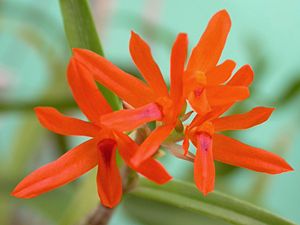Hexisea: Difference between revisions
imported>Dalton Holland Baptista No edit summary |
imported>Dalton Holland Baptista No edit summary |
||
| (One intermediate revision by the same user not shown) | |||
| Line 1: | Line 1: | ||
{{subpages}} | {{subpages}} | ||
{{Image|Scaphyglottis bidentata.jpg|right|300px|'''''Scaphyglottis bidentata'''''<br><small>This species, now classified under the genus ''Scaphyglottis'' | {{Image|Scaphyglottis bidentata.jpg|right|300px|'''''Scaphyglottis bidentata'''''<br><small>This species, now classified under the genus ''Scaphyglottis''.</small>}} | ||
'''''Hexisea''''' is an orchid genus currently considered a synonym of genus ''[[Scaphyglottis]]''. ''Hexisea'' was described by [[John Lindley]] in 1834 and its type species is ''H. bidentata''. | '''''Hexisea''''' is an orchid genus currently considered a synonym of genus ''[[Scaphyglottis]]''. ''Hexisea'' was described by [[John Lindley]] in 1834 and its type species is ''H. bidentata''. | ||
| Line 9: | Line 9: | ||
From these, three were moved to ''Scaphyglottis'' before 1993, when [[Robert Louis Dressler]] published his ''Field guide to the orchids of Costa Rica and Panama''. | From these, three were moved to ''Scaphyglottis'' before 1993, when [[Robert Louis Dressler]] published his ''Field guide to the orchids of Costa Rica and Panama''. | ||
The remaining species were ''H. bidentata'' and ''H. imbricata''. They are the most showy ''Scaphyglottis'' species because they have red flowers. Both are pollinated by [[hummingbird]]s and can be separated by a yellow callus ''H. imbricata'' has on the labellum and in ''H. bidentata'' is replaced by a triangular purple mark that goes down towards its apex. | The remaining two species were ''H. bidentata'' and ''H. imbricata'', which were moved to ''Scaphyglottis'' in 1994. They are the most showy ''Scaphyglottis'' species because they have red flowers. Both are pollinated by [[hummingbird]]s and can be separated by a yellow callus ''H. imbricata'' has on the labellum and in ''H. bidentata'' is replaced by a triangular purple mark that goes down towards its apex. | ||
==List of synonyms== | ==List of synonyms== | ||
Latest revision as of 12:57, 31 March 2009
Hexisea is an orchid genus currently considered a synonym of genus Scaphyglottis. Hexisea was described by John Lindley in 1834 and its type species is H. bidentata.
Hexisea and Scaphyglottis used to be separated because Hexisea flowers have the labellum partially fused to the column base; it is not motile and is abruptly bent down after the column, furthermore, the columns of their flowers do not show a well developed foot.
Previously to the name Hexisea, sometimes misspelled in literature as Hexesea and Hexisia, was rejected by the Intenational Code of Botanical Nomenclature against Scaphyglottis, its five accepted species were, H. arctata, H. bidentata, H. imbricata, H. lankesteri and H. oppositifolia.
From these, three were moved to Scaphyglottis before 1993, when Robert Louis Dressler published his Field guide to the orchids of Costa Rica and Panama.
The remaining two species were H. bidentata and H. imbricata, which were moved to Scaphyglottis in 1994. They are the most showy Scaphyglottis species because they have red flowers. Both are pollinated by hummingbirds and can be separated by a yellow callus H. imbricata has on the labellum and in H. bidentata is replaced by a triangular purple mark that goes down towards its apex.
List of synonyms
- Hexisea Lindl., J. Bot. (Hooker) 1: 7 (1834) see Scaphyglottis.
- H. amparoana (Schltr.) Ames, F.T.Hubb. & C.Schweinf., Bot. Mus. Leafl. 3: 40 (1934) see Scaphyglottis amparoana.
- H. arctata Dressler, Orquídea (Mexico City), n.s., 7: 223 (1979) see Scaphyglottis arctata.
- H. aurea (Rchb.f.) Dressler, Taxon 13: 246 (1964) see Scaphyglottis aurea.
- H. bicornis (Lindl.) Dressler, Phytologia 21: 442 (1971) see Scaphyglottis bicornis.
- H. bidentata Lindl., J. Bot. (Hooker) 1: 8 (1834) see Scaphyglottis bidentata.
- H. bidentata var. imbricata (Lindl.) C.Schweinf., Bot. Mus. Leafl. 15: 106 (1951) see Scaphyglottis imbricata.
- H. cuniculata (Schltr.) Ames, Schedul. Orchid. 9: 48 (1925) see Scaphyglottis cuniculata.
- H. imbricata (Lindl.) Rchb.f. in W.G.Walpers, Ann. Bot. Syst. 6: 470 (1862) see Scaphyglottis imbricata.
- H. lankesteri Ames, Schedul. Orchid. 9: 47 (1925) see Scaphyglottis subulata.
- H. oppositifolia (A.Rich. & Galeotti) Rchb.f. in W.G.Walpers, Ann. Bot. Syst. 6: 470 (1862) see Scaphyglottis imbricata.
- H. reflexa (Lindl.) Rchb.f. ex Griseb., Fl. Brit. W. I.: 623 (1864) see Scaphyglottis reflexa.
- H. reflexa Rchb.f., Linnaea 41: 131 (1877) see Scaphyglottis emarginata.
- H. sigmoidea Ames & C.Schweinf., Schedul. Orchid. 8: 39 (1925) see Scaphyglottis sigmoidea.
